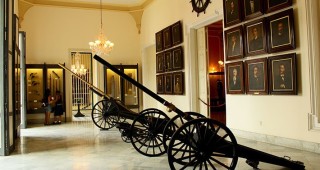My first impulse always takes me for a walk along the old wooden pier where a few of the locals are seated trying their luck at fishing. Many of these people are oldsters who can remember many of those events that are part of local history. A few moments later I was chatting with a grey-haired man with cap and moustache, almost at the end of the pier, who told me that he had seen the writer Ernest Hemingway there several times. As he spoke I caught the glimpse of a special twinkle in his eyes and I understood the pride he felt living here all these years.
The Torreón de Cojímar is close to the pier, an ancient fortress which today is surrounded by some buildings dating from more modern times. When the English invaded Havana in 1762, the Spanish defended the city from this small fortification. More than two hundred years later, you can still feel the power of that past, even as you are enjoying the tranquil scenery.
My eyes, however, wondered off and I caught sight of the first monument erected in memory of Hemingway one year after his death. It is said that the town’s residents, including Gregorio Fuentes, collected metal pieces from propellers, chain links and anchors to cast the bronze bust by Cuban sculptor Fernando Boada Martín. It stands beneath a neoclassical archway in front of the fort.
I bumped into two musicians, one of whom told me he had talked to Hemingway several times. What he remembered most was the American’s friendliness and that he liked to hang out with “regular folk,” convinced that he had a lot to learn from such people.
I was both jealous and excited to hear the man casually describe the appearance of the US Nobel Prize winner; in the words of that trovador I was starting to see a strong image that was clearer than any photograph I might have ever seen before. The tall, white, heavyset man with deep blue eyes had gained new dimensions. When he finished his description, the musician started to play the song he remembered to be Hemingway’s favorite.
Just three hundred meters from that encounter was the La Terraza Bar and Restaurant. I’ve visited it many times and it is definitely the best place to strike up a dialogue with the writer of “The Old Man and the Sea,” “Islands in the Stream” and “For Whom the Bell Tolls.” You can order a delicious fish or the always succulent shrimp. While you wait, there is the authentic daiquiri and a view of that same sea where the writer, accompanied by Gregorio Fuentes, his great friend and the skipper of the Pilar, would set off to fish.
Source of bounty and sacrifices, the sea has been the scenario for many years for the international fishing tournament called the Hemingway Marlin Tournament in Memoriam. Many of the fishermen on the pier tell of incredibly large specimens that were captured. Humble men, skins bronzed by the sun, set off in boats every day there to try to catch fish for their families.
On the La Terraza walls, we can see a gallery of photographs and other valuable documents tracing an important part of Hemingway’s trajectory in Cuba. There is a plaque bearing a small relief of his face at the table where he liked to sit and smoke one of his trademark Cuban cigars while waiting for his meals.
I left La Terraza and headed towards the pier, wandering around the shore that decades ago was one of the most famous resorts in Cuba until it was replaced by other beaches such as Guanabo, Jibacoa and, especially, Varadero. As I walked, I enjoyed seeing the leisurely lives of the inhabitants which, as they commented to me, was totally different from the city life-style.
When I got to a small steel bridge that opens to allow tall boats to pass through, I noticed a kind of fishermen’s cooperative engaged in a ceremony celebrating the arrival of a new ship. The newcomers get to uncover a canvas-covered trophy to the reactions of the workers who had been looking after it. I spent a few minutes on the bridge, looking at the process of cleaning and filleting fish. The parts discarded become food for other fish and marine animals.
By now the sun was sending me signals it was time to leave. As I strolled to the center of town, I felt renewed and with a justifiable desire to reread some of Hemingway’s book.




 Eclectic
Eclectic






